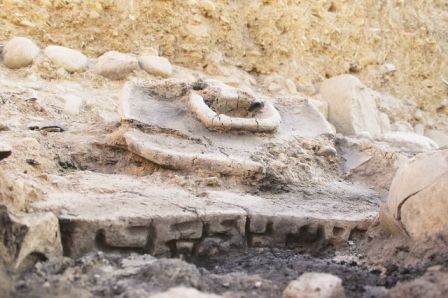Grakliani Unique Inscription Proved as the Oldest

26 July, 2016
The unique inscription of Grakliani discovered by the archaeological expedition from Ivane Javakhishvili Tbilisi State University (TSU) dates back to the 11th or 10th century BC, a top American laboratory confirms.
Vakhtang Licheli, who heads the university’s archaeology institute and leads the expedition, said that the inscription discovered at the Grakliani Hill aroused special interest because apparently it is the oldest in Georgia. So, the TSU expedition decided to send some samples to the Miami-based Beta Analytic, the world's largest professional radiocarbon dating laboratory, to specify the date of the inscription.
According to Vakhtang Licheli, the U.S. lab confirmed that the inscription dates back to the 11th or 10th century BC that is an absolutely unique phenomenon. He also noted that to recheck the date the samples have been sent to Italy.
Acting Rector of TSU, Professor Darejan Tvaltvadze noted that “archaeologists from Ivane Javakhishvili Tbilisi State University began working at the Grakliani Hill site in 2008, when a station for scientific research and field work was created. During this period our archaeologists made a lot of important discoveries. The conclusion of the U.S. laboratory has reaffirmed the unique nature of Grakliani inscription. This discovery may well change the history of writing in Georgia – and in the world.”
In a temple with two altars dating to the 7th century BC and dedicated to a fertility goddess, inscriptions are visible on both of the altar pedestals. The unique inscription belongs to an absolutely distinguished, individual writing, which has no analogs in the world.
This new discovery shows that Georgia has at least a 2700-year history of writing. This and previously discovered materials might well change the history of eastern Georgia, particularly Kartli of the 7th and 6th centuries BC. The writing in the temple is well-preserved on both altars. Several letters are carved on one, facing westwards, and the pedestal of the other altar is completely covered with similar inscriptions.
Grakliani Hill is an archaeological monument where the development of humans has been confirmed from the Stone Age to Antiquity. Artifacts discovered within 11 layers, and which comprise several periods, include tools belonging to primitive cultures – such as cult items and a “pharmaceutical device”, a kind of spatula for mixing drugs and solutions. This intriguing architectural picture gradually emerged as a block of buildings situated close to each other, yielded significant objects such as a golden disc from the 5th – 4thmillennium BC. Its only analog is found in Suzar, Iran, with a seal from the 4th millennium BC. A similar object was found in Southern Mesopotamia.
There are several cult rooms including a “cult mill”, a three-part hand-mill with which holy flour was ground to bake bread and sacrifice it to idols.
Vakhtang Licheli, who heads the university’s archaeology institute and leads the expedition, said that the inscription discovered at the Grakliani Hill aroused special interest because apparently it is the oldest in Georgia. So, the TSU expedition decided to send some samples to the Miami-based Beta Analytic, the world's largest professional radiocarbon dating laboratory, to specify the date of the inscription.
According to Vakhtang Licheli, the U.S. lab confirmed that the inscription dates back to the 11th or 10th century BC that is an absolutely unique phenomenon. He also noted that to recheck the date the samples have been sent to Italy.
Acting Rector of TSU, Professor Darejan Tvaltvadze noted that “archaeologists from Ivane Javakhishvili Tbilisi State University began working at the Grakliani Hill site in 2008, when a station for scientific research and field work was created. During this period our archaeologists made a lot of important discoveries. The conclusion of the U.S. laboratory has reaffirmed the unique nature of Grakliani inscription. This discovery may well change the history of writing in Georgia – and in the world.”
In a temple with two altars dating to the 7th century BC and dedicated to a fertility goddess, inscriptions are visible on both of the altar pedestals. The unique inscription belongs to an absolutely distinguished, individual writing, which has no analogs in the world.
This new discovery shows that Georgia has at least a 2700-year history of writing. This and previously discovered materials might well change the history of eastern Georgia, particularly Kartli of the 7th and 6th centuries BC. The writing in the temple is well-preserved on both altars. Several letters are carved on one, facing westwards, and the pedestal of the other altar is completely covered with similar inscriptions.
Grakliani Hill is an archaeological monument where the development of humans has been confirmed from the Stone Age to Antiquity. Artifacts discovered within 11 layers, and which comprise several periods, include tools belonging to primitive cultures – such as cult items and a “pharmaceutical device”, a kind of spatula for mixing drugs and solutions. This intriguing architectural picture gradually emerged as a block of buildings situated close to each other, yielded significant objects such as a golden disc from the 5th – 4thmillennium BC. Its only analog is found in Suzar, Iran, with a seal from the 4th millennium BC. A similar object was found in Southern Mesopotamia.
There are several cult rooms including a “cult mill”, a three-part hand-mill with which holy flour was ground to bake bread and sacrifice it to idols.
